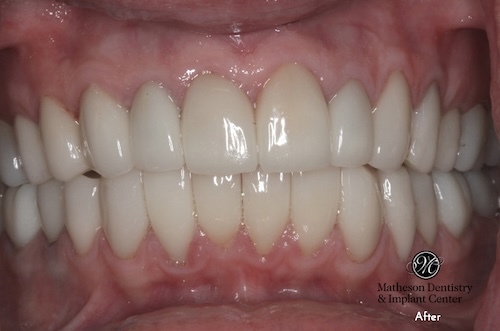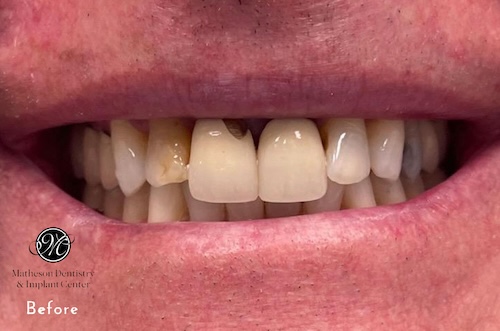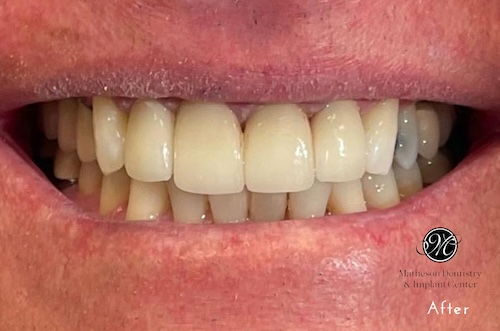Why do dentists put crowns on teeth?
Dentists put crowns on teeth for a variety of reasons. Basically, crowns are used when teeth become weak. This could be due to a crack in a tooth or because of a filling that was placed a long time ago. Over time, our teeth just become weaker. When a tooth is at the point where it's likely to break, we put a crown on it to prevent further problems.
What type of dental crown is best for a molar?
There are several types of crowns. At Matheson Dentistry, we prefer to use zirconia crowns for molars. Zirconia is a relatively new material in dentistry that is very strong and hard, making it resistant to breakage. It also looks appealing because it is white and can be color-matched to your tooth, providing an excellent outcome.
What kind of crown is best for front teeth?
When it comes to front teeth, aesthetics are crucial. The material should be strong and functional while looking natural. We often use porcelain for front teeth crowns because it offers the balance of strength and a natural appearance.
Is it important to get a dental crown after a root canal?
Yes, it is crucial to get a crown after a root canal. A tooth becomes more brittle and susceptible to breaking after a root canal. To prevent the tooth from breaking and potentially needing removal, we recommend placing a crown on it.
How do different dental crown materials compare?
There are multiple materials for crowns. Gold crowns were once common, known for their strength and durability, though not everyone wants gold in their smile. Porcelain has been used for a long time and is valued for its natural appearance, though it's not as strong as zirconia. At Matheson Dentistry, we often use zirconia for back teeth due to its strength and tooth-like color, and porcelain for front teeth for its natural look and improved strength.
Are crowns as strong as real teeth?
While nothing matches the natural strength of real teeth, modern crowns are very strong. Zirconia crowns, in particular, are extremely durable. You could hit them with a hammer, and they wouldn't break. For back teeth, we prefer zirconia crowns because of their strength and durability.
What are the steps of the dental crown procedure?
The dental crown procedure begins with a visit to the office where we numb the area to prevent pain. We prepare the tooth with a dental drill and take a digital impression. This impression is sent to a lab to make the crown. Once ready, the patient returns for the final fitting and cementation of the crown on the tooth.
What type of anesthesia will I need for a dental crown?
Typically, a local anesthetic is used for dental crowns to numb the area and eliminate pain. For patients anxious about the procedure, we offer sedation options such as laughing gas, a calming pill, or even the option to be asleep during the procedure.
Are there special instructions for brushing and flossing after getting a dental crown?
After getting a dental crown, it's important to keep the area clean. The cleaning instructions are the same as for regular teeth: brush, floss, and visit the dentist every six months for a cleaning. This ensures the crown remains sealed and everything stays in good condition.
What is the average life expectancy for a dental crown?
If maintained properly, a dental crown should last for many years. However, cavities can still form underneath if not kept clean. Regular brushing, flossing, and biannual dental cleanings are essential to ensure the longevity of the crown.
What is the typical cost for a dental crown?
The cost of a dental crown varies depending on factors like dental insurance and the type of crown. For an accurate estimate, it's best to come in for a no-cost consultation. We'll examine your tooth and provide a cost estimate for the crown.
How can I schedule an appointment for a dental crown?
If you need a crown or have a broken tooth, call us at (480) 888-8123. Our front office staff will set up a no-cost consultation to assess your tooth and determine if a dental crown is necessary.
Crowns and bridges are two of the most widely used tooth restorations out there. Crowns are popularly known as ‘dental caps’ as they are hollow on the inside and fit over a tooth. Bridges are used to replace missing teeth that are extracted due to external trauma, cavities, gum diseases, etc. Since both of them are made from tooth-colored ceramic material, they perfectly restore the aesthetics of the smile.
When are crowns used?

Crowns are known to have a wide array of uses. They are used to treat the following type of conditions:
- Misshapen teeth: Teeth that are naturally out of shape are called misshapen teeth. They can be made to look better by bonding crowns to their surface.
- Chipped teeth: Teeth may sometimes undergo damage when the patient takes a hard blow to the mouth. This can result in the tooth losing a certain edge, giving the smile a displeasing look. Crowns can be used to restore such teeth as well.
- Cracked or broken teeth: Though the enamel is the hardest part of the human body, it may break or sustain cracks when the patient takes a hard blow to the mouth or has a bad fall. When left untreated, the tooth could get infected or completely fail due to crack propagation. Hence, restoring it with a crown is a great way to save it.
- Worn out teeth: Regular wear of the teeth isn’t harmful. But, when the patient suffers from a condition called bruxism, which is night-time teeth grinding, the teeth may get worn down to the stumps. This ruins their aesthetics and makes it quite difficult to chew food. Crowns would perfectly restore the tooth to its ideal shape and size.
Why should you choose crowns and bridges?
- Oral aesthetics is just as important as one’s oral health. Hence, we recommend tooth-colored crowns and bridges to our patients as they would be indistinguishable amidst the natural teeth. They can be customized and made to perfectly mimic the appearance of the teeth.
- The ceramic material used to fabricate them is highly durable and long-lasting. Also, it is quite a stain-resistant.
- They help to save the natural tissues of the teeth as they prevent extractions.
- Crowns strengthen a weak and damaged tooth, thereby holding it together.
- Bridges prevent the drifting of the teeth which occurs due to the gap left by the missing tooth.
- You can resume your everyday activities, such as biting, chewing, etc., like normal after getting the restorations.
How are crowns and bridges placed?
During the initial visit, the dentist would conduct a thorough screening of the teeth to determine the severity of the condition. Depending on the observations and the factors that could affect the treatment procedure, the candidacy for the restorations will be confirmed. The teeth will be cleaned thoroughly and a thin layer of enamel will be removed to make space for the restorations. A highly precise digital mold will be taken to serve as a reference. This will be used to fabricate the restorations in a dental laboratory. Until then, temporary restorations may be placed on the teeth.
Once the permanent restorations are fabricated, the teeth will be cleaned and etched. This is done to roughen their surface and provide a good grip for the ceramic appliances. Dental adhesives will be used to bond them to the prepared tooth, after which a curing light will be used to harden it. It may be polished to enhance the appearance and a bite test would ensure perfect fit and comfort.
Restore the aesthetics of your smile with dental crowns & bridges at Matheson Dentistry & Implant Center in Queen Creek, AZ. Call us now!
Heather's Before & Afters


Heather had faced a lifetime of cavities and patchwork fillings that detracted from her smile. We used lifelike porcelain crowns to treat her smile. Now her smile is beautiful and cavity free.
Ken's before & Afters


Ken wasn't happy with the old, chipped crowns on his front teeth that looked so different than his natural teeth. We made new crowns for 6 teeth across the front and look at his new bright, natural looking smile now!



